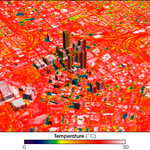Urban Heat Island Effect
b) Why is Urban Heat Island a Concern?

Urban heat island is a major concern because it causes an increase in energy consumption, reduces air quality, compromises human health and can impair water quality.
Energy Consumption
“On a hot, sunny summer day, the sun can heat dry, exposed urban surfaces, such as roofs and pavement, to temperatures 50–90°F hotter than the air” (USEPA, 2011). This increased temperature causes consumers to increase their energy consumption through fans and air conditioners to combat the uncomfortable heat. In large cities UHI affects millions of people which can cause huge energy demands. Specifically in the summer months, when the energy demand is high; one hot summer day can overdrive peak energy demand and black out an entire metropolitan area.
One of the most infamous blackouts occurred during the summer of 2003. The areas affected included the Northeastern and Midwestern United states and Ontario, Canada. Over 55 million people were affected making it the second largest widespread blackout in history (Wikimedia, 2011). The blackout was triggered by a seasonally hot day in August between 4:10 and 4:14pm, typically the hottest part of the day(Wikimedia, 2011). The ambient air temperature was approximately 88°F however due to UHI in some areas the surface temperature could of reached well over 100°F. As a result, people turned on their fans and air conditioners, causing an increased energy demand and ultimately increased the temperature of transmitting power lines causing them to sag. For the majority of the area affected, the power was restored by early the following morning, however full power was not completely restored until four days later, specifically in Canada.
Air Quality
Air quality is affected through an increase in greenhouse emissions and other air pollutants. Due to the increased energy demand, more air pollutants are emitted during energy production. The increased temperature can also cause the formation of ground level ozone, also known as smog (USEPA, 2011).
The most common pollutants emitted from power plants include sulfur dioxide, nitrogen oxides, particulate matter, carbon monoxide and mercury (USEPA, 2011). These pollutants can have serious effects on human health and environmental quality. Alone or in combination, these pollutants are responsible for the formation of smog, acid rain and fine particulate matter. Carbon dioxide is another common pollutant emitted from power production, specifically in coal/fossil-fuel plants. The reduced air quality caused by these pollutants can cause respiratory difficulties especially in the elderly and those who suffer from asthma.
Human Health
Human health is affected by UHI through increased temperature and reduced air quality. The increased temperature can cause heat cramps and exhaustion, non-fatal heat stroke, and heat-related mortality (USEPA, 2011). The most serious types of heat-related illness are heat stroke and heat exhaustion. The people who are at the highest risk of heat-related illness are the elderly, children and those who suffer from a pre-existing condition like heart disease (USDHHS, 2003).
One documented example of how UHI affects human health occurred in Chicago Illinois. Chicago is large metropolitan area that is affect by UHI and has a long history of extreme heat events. Two of the most notable heat waves occurred in the summers of 1995 and 1999. Heat waves can be defined as the three or more consecutive days of air temperature equal or greater than 90°F (USDHHS, 2003). During the summer of 1995, there were 485 heat-related deaths and 739 excess deaths. Similar devastation occurred in 1999, resulting in 103 heat-related deaths and 80 deaths attributed to extreme heat (USDHHS, 2003).
Chicago is only one example of how extreme heat events can seriously affect human health. Due to their history of heat waves, Chicago has pioneered several technologies to help mediate the effects of UHI including “green roofs” (see Case Study).
Water Quality
Water quality is affected by UHI through contamination by storm water runoff. Storm water runoff is contaminated by running off hot surfaces like roof tops or pavement. When the water comes in contacted with these super-heated surfaces the water temperature increases. When the runoff is discharged into the receiving water body, the runoff is significantly warmer, and can increase the temperature of the water body. A slight increase in water temperature can have detrimental effects on the aquatic ecosystems. Specifically, increased water temperature can reduced the dissolve oxygen concentration causing harmful effects on the metabolisms and respiratory systems of aquatic life (USEPA, 2011).
Section a) Introduction (HOME)
Section b) Why is Urban Heat Island a Concern?
Section c) How Climate Change will Affect UHI (NEXT)
Section d) Measuring the Urban Heat Island Effect
Section e) How can Urban Heat Island be Remediated?
Section f) Mitigation at Local/Regional/National Level
(By Kiersten Lee/Gregory Möller)

